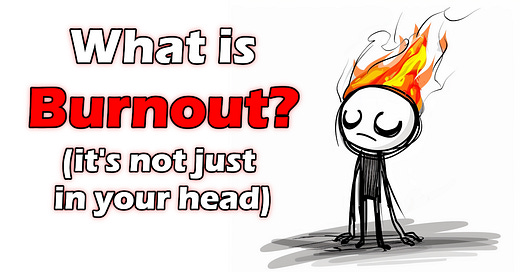Understanding Burnout: The Five Interlocking Systems
Burnout is a complex syndrome that affects millions of people, yet remains poorly understood by mainstream medicine. This comprehensive guide explores what burnout really is - not simply "being tired" or "needing a vacation," but a profound physiological state involving five interconnected bodily systems. By understanding these systems and how they interact, you can better navigate your path to recovery.
What Burnout Really Feels Like
If you've experienced burnout, you know it's far more than just feeling tired. You might have days where you feel relatively normal, followed by days where getting off the couch seems impossible. Your body might suddenly develop strange sensitivities - foods you've enjoyed your whole life now cause digestive distress, or you find yourself constantly too hot or too cold. Sleep becomes elusive despite extreme fatigue. Your thinking becomes foggy, your memory unreliable, and your emotions more volatile. These aren't just random symptoms - they're the result of multiple bodily systems being thrown into dysfunction by prolonged stress.
Many people with burnout report unexplained physical symptoms: diffuse pain throughout the body, inflammation in unexpected places (like chronic sinus issues), dizziness when standing up (POTS), and a general sense that their body simply isn't working correctly. If these experiences sound familiar, you're not imagining things, and you're not alone.
Why Burnout Is So Misunderstood
Modern medicine excels at addressing acute problems with clear causes and treatments, but struggles with complex multi-system conditions like burnout. Most doctors receive minimal training on chronic conditions, and virtually none on how different bodily systems interact in states of prolonged stress. When you visit a specialist, they examine only their area of expertise - a gastroenterologist looks at digestive issues, a neurologist at brain symptoms - but rarely does anyone look at the full picture.
This fragmented approach leads to medical gaslighting - being told "your labs are normal, it must be stress" or "this sounds like depression" without investigating the underlying physiological causes. Some providers dismiss "adrenal fatigue" as pseudoscience, despite extensive research on HPA axis dysfunction (the medical term for what many call adrenal fatigue). Others will acknowledge only the most extreme manifestations like Chronic Fatigue Syndrome, missing opportunities for earlier intervention.
The Five Systems Behind Burnout
Burnout involves five primary overlapping systems that become dysfunctional or dysregulated. Understanding these systems is key to addressing the root causes rather than just managing symptoms.
1. HPA Axis Dysfunction
The hypothalamic-pituitary-adrenal (HPA) axis is your body's main stress response pathway. This system connects your brain to your adrenal glands and regulates energy, stress hormones, and your ability to adapt to challenges. When chronically activated, this system eventually loses its ability to respond appropriately.
This dysfunction manifests as cortisol irregularities - either producing too little overall, or producing it at the wrong times. If you struggle to wake up in the morning, you might have insufficient morning cortisol. If you wake too early and can't fall back asleep, you might have inappropriate early cortisol spikes. Recovery from HPA axis dysfunction typically takes 6 months to 2 years, with severe cases taking 3-5 years.
2. Autonomic Nervous System (ANS) Dysfunction
Your autonomic nervous system controls unconscious bodily functions like heart rate, blood pressure, digestion, and temperature regulation. Burnout can cause dysautonomia - a state where your sympathetic ("fight-or-flight") system becomes dominant, while your parasympathetic ("rest-and-digest") system becomes underactive.
Symptoms include heart palpitations, dizziness when standing up, temperature regulation problems, digestive motility issues (feeling like food sits in your stomach for hours), and heightened sensitivity to environmental stimuli. Getting "stuck" in sympathetic dominance keeps your body in a state of hypervigilance, preventing proper rest and recovery.
3. Gastrointestinal System Dysfunction
Your digestive system is often called your "second brain" for good reason - it produces 90% of your serotonin and houses its own nervous system (the enteric nervous system). The gut plays a critical role in immune function and overall health.
Burnout can affect your gut through several mechanisms: chronic stress can impair the gut lining (leading to "leaky gut"), infections like H. pylori can cause inflammation, and your microbiome (the trillions of bacteria in your digestive system) can become imbalanced. When your gut is compromised, the effects ripple throughout your entire body, causing nutrient deficiencies, systemic inflammation, immune dysregulation, and altered neurotransmitter production that affects mood and cognition.
4. Mitochondrial Dysfunction
Mitochondria are the power plants of your cells, producing the energy currency (ATP) that fuels all cellular activities. During burnout, these vital organelles become damaged and less efficient. Their internal structures (cristae) can physically deform, and they shift to less efficient energy production methods.
The result is profound fatigue at a cellular level - your body literally cannot produce enough energy to function optimally. Every tissue, organ, and system feels the effects of this energy deficit. The good news is that mitochondria can recover with proper support, as they contain their own DNA and can regenerate when given the right conditions.
5. Immune System Dysfunction
Your immune system becomes dysregulated during burnout, often becoming simultaneously overactive in some ways and underactive in others. This paradoxical state can manifest as frequent infections (showing immune weakness) alongside inflammatory conditions and hypersensitivities (showing immune overactivity).
Chronic inflammation becomes a persistent problem, creating a constant state of low-grade immune activation that further drains your energy resources and affects brain function, healing ability, and overall wellbeing. Many people with burnout develop new sensitivities to foods, chemicals, or environments that never bothered them before.
The Vicious Cycle and Downward Spiral
What makes burnout particularly challenging is how these five systems interact and reinforce each other's dysfunction. HPA axis problems disrupt sleep, which impairs mitochondrial recovery. Gut issues create inflammation that triggers immune responses and stresses the HPA axis further. Mitochondrial dysfunction means less energy for healing and proper system function.
Minor burnout can resolve on its own with sufficient rest and stress reduction. However, once a certain threshold is crossed, these systems keep each other sick in a self-perpetuating cycle. Without targeted interventions addressing each affected system, recovery becomes extremely difficult or impossible. This explains why some people remain burned out for years or decades despite their best efforts to rest and reduce stress.
Navigating Medical Support
Unfortunately, most healthcare providers aren't equipped to address burnout as a multi-system condition. This means you must often become your own health advocate and case manager. Some strategies include:
When seeking medical help, speak the language of the specialist you're consulting. Instead of saying "adrenal fatigue" (which many doctors dismiss), use terms like "HPA axis dysfunction" or "dysautonomia" that align with medical terminology.
Request appropriate testing. Standard bloodwork often misses the markers of burnout. More specialized tests like comprehensive stool analyses, organic acid tests, or cortisol rhythm testing can reveal the underlying issues.
Consider working with integrative or functional medicine practitioners who are more likely to understand complex, multi-system conditions. However, be cautious, as quality varies widely in these fields.
Remember that your experience is real and valid, even when healthcare providers can't immediately identify the cause. Persistent advocacy may be necessary to get the support you need.
Recovery Is Possible But Takes Time
Recovering from burnout is a gradual process that cannot be rushed. In fact, trying to accelerate recovery through sheer willpower often backfires, causing setbacks and prolonging the journey. The first rule of burnout recovery is "don't make it worse" - which means avoiding overexertion, respecting your body's current limitations, and prioritizing rest and healing above productivity.
Recovery requires addressing all affected systems simultaneously through a combination of lifestyle changes, targeted supplements, stress management, diet modifications, and sometimes medications. This process is highly individualized - what works for one person may not work for another due to genetic differences, varying dietary needs, different lifestyle factors, and unique personal circumstances.
The journey to recovery often requires significant changes to how you live and work. It may mean rethinking career choices, relationship dynamics, living situations, and fundamental priorities. While challenging, this process can ultimately lead to a more sustainable and fulfilling life built on a deeper understanding of your body's needs.
Conclusion
Burnout is not a character flaw or a sign of weakness - it's a complex physiological condition involving multiple bodily systems. By understanding the five key systems involved and how they interact, you can begin to address the root causes rather than just managing symptoms.
Recovery is possible, but it requires patience, persistence, and a willingness to make meaningful changes. The path forward involves supporting your body's natural healing processes while avoiding the patterns that led to burnout in the first place. With the right approach, you can not only recover from burnout but emerge with greater resilience and a more balanced relationship with stress.













Share this post